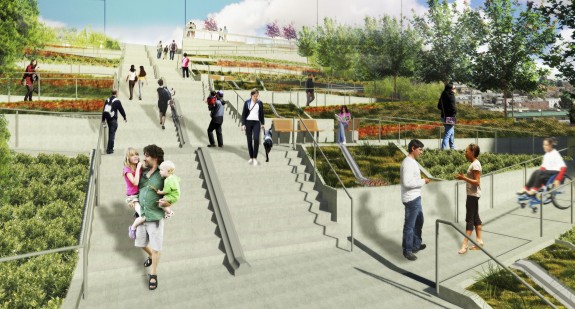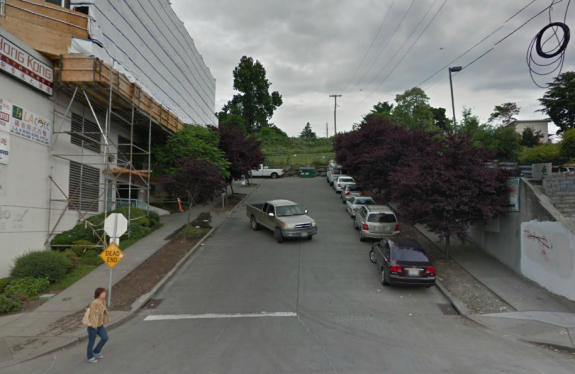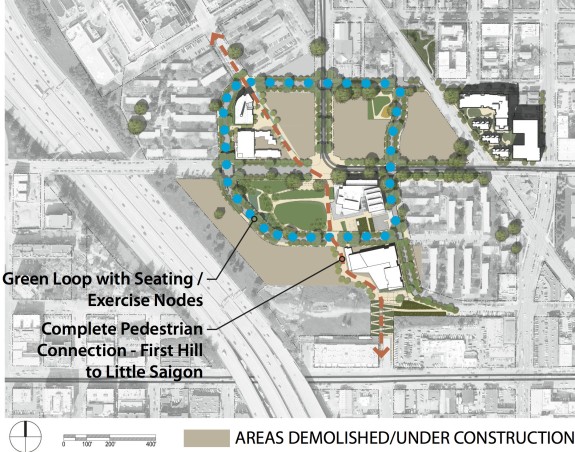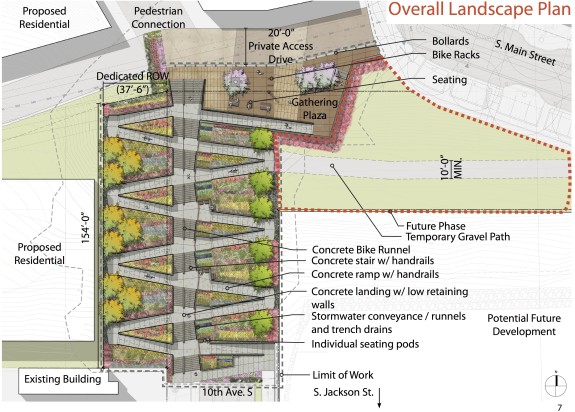
One of the most interesting upcoming projects for people on foot and bike in Seattle has not received much attention yet, but it could revolutionize the way people get to and from Yesler Terrace and First Hill.
The 10th Ave S Hill Climb is largely grant-funded and part of a street vacation deal with the city as part of the large-scale redevelopment of Yesler Terrace that is now underway. Construction on the hill climb is scheduled to begin this year.
When completed, the stairway and gradual ADA ramp will connect Yesler Terrace to Jackson Street, Little Saigon and the International District. It will also likely be a stunning place to hang out and enjoy the stunning view from the south side of a very steep part of First Hill.
Today, 10th Ave S does not go through, and very steep grades leave very few options for moving between Yesler Terrace and Jackson Street, especially if you are on a bike or have mobility issues. Here’s how the hill climb area looks today:

The hill climb will not likely be a high-volume bike route, and it’s not really designed to be. In fact, it’s not even listed on the Bike Master Plan draft (though it probably could be noted as a desired “neighborhood connector” route). But it could be a game-changing connection for people who live, work or play in Yesler Terrace and parts of First Hill.
It will also help connect to the Broadway Bikeway, which is not marked on the map below but follows the streetcar tracks north from the heart of Yesler Terrace:
 The hill climb is also the first attempt I have seen by the city to install a runnel in the middle of a stairway, where there is no handrail to get in the way of people pushing their bikes up the hill:
The hill climb is also the first attempt I have seen by the city to install a runnel in the middle of a stairway, where there is no handrail to get in the way of people pushing their bikes up the hill:
 For more on the project, check out their recent presentation to the City Council Transportation Committee (starts around 33:00 mark):
For more on the project, check out their recent presentation to the City Council Transportation Committee (starts around 33:00 mark):








Comments
22 responses to “A look at the amazing planned Yesler Terrace hill climb”
I’m excited about the runnel (and the whole project). But I also appreciated Tom Rasmussen’s concern about the connection along the existing section of 10th. It’s pretty steep, steeper I’m sure than ADA grade – so how do people with mobility issues – or normal people on bikes – get to the bottom of the beautiful ADA stairway with its beautiful runnel?
That’s a good point. That block is more than 10% grade, which is not super fun and definitely not ADA-compliant. What options are there? Another hill climb? That would be cool.
There are a couple of elevators that bypass the hillclimbs on the downtown waterfront in the general vicinity of the pike place market. They seem to work over there.
It’s good to see some progress in the part of town in question, it has long been pretty awful to get around in no matter what your mode.
It’s worth remembering that ADA standards don’t mean that people in wheelchairs are all incapable of traversing steeper grades. It’s not a binary access/no access threshold.
Facilities that meet ADA slopes make it easier for a wider range of people to get around without assistance, but many people in wheelchairs (and ordinary people on reasonable bicycles) routinely traverse slopes steeper than ADA would allow.
We shouldn’t insist that everything needs to meet ADA before anything can meet ADA — incremental improvements still improve access, even if they don’t accommodate absolutely everyone.
Sure, but it is a little silly to build ADA-grade ramp for only 2/3 of a hill…. But I agree, it’s a lot better than nothing.
If 2/3 of the hill is the limit of the project scope, take the 2/3 that’s in scope and use it as leverage to get the remaining 1/3 of the hill.
The 2/3 takes care of what’s now completely impassable, the 1/3 is at least an existing paved street and sidewalk, though too steep for some to use comfortably.
Given that a lot of wheelchairs these days are powered by electricity, does steepness really matter as much as it used to (at least for wheelchairs – obviously, for people riding bikes, it still matters a great deal)? With an electric motor, a wheelchair should be able to get up almost any grade.
ADA standards are intended to set a standard that doesn’t require powered wheelchairs, and that even quite elderly users are strong enough to navigate under their own power.
Powered wheelchairs, not to mention even more powerful, long-range mobility devices, do open many more places to the people who can afford powered devices.
My late mother’s Hoveround manual said not to climb more than an 8-degree slope, which is a bit over 14%, but from experience I can say it was great at hauling groceries up a paved 18% path that left many pedestrians pausing for breath. That’s as steep as the Queen Anne Counterbalance.
A 10% grade isn’t ADA-compliant, but if it’s hard-paved with good traction, it’s still quite navigable for many disabled users.
Josh, go take a look at that section of 10th just north of Jackson. It’s more than a little bit steeper than ADA. I’m a reasonably fit old lady, I ride up and down Capitol Hill most days, but I can’t get even halfway up that hill on my bike. I understand we can’t make every street ADA accessible, but going to the expense of creating a whole ADA accessible hillside and not paying attention to this critical link just doesn’t make sense.
I’m very excited for a connection there and for runnels generally. But I wonder whether placing the runnel in the center of the stairway will turn the stairway into a skateboard park. Would it be better to place the runnel under the handrails on either side?
I’m thinking something like the runnel in this photo:
http://media-cache-ec0.pinimg.com/236x/73/3e/b6/733eb63e96ebfc7296927652ef3a8b4d.jpg
Unfortunately, placing the runnel under the railing can create conflicts between cyclists and pedestrians who really need that railing. Not every cyclist is willing to slow to the pace of a person with limited mobility or balance issues, and they aren’t always prepared to pull their bike out of the runnel and walk around.
Vehicles and pedestrians often don’t mix all that well, and one of the advantages of runnels is that they encourage bicycles to self-segregate, reducing pedestrian conflicts.
If skateboards are a real concern, the projecting edges of the runnel can be make less grind-friendly — keep the runnel channel smooth, but make the top stepped or crenellated.
Another alternative is to put the handrail in the center of the staircase, and bike ramps on the sides, without the projecting edges of a runnel. That doesn’t provide the wheel guidance of a runnel, cyclists still have to hold their handlebars on the stairs instead of just pushing the seat, but it provides the same self-segregation benefit for pedestrians and keeps the handrail and bike traffic separate. See the stairs down to Lake Washington by the I-90 Trail as an example.
I always cringe when I hear advocates for active transportation worrying about infiltration of skateboarders. To me, it’s similar to a driver complaining about the infiltration of bicycles on “their” roads. Why the skateboard shaming?
Agreed. In the presentation, discouraging skateboarders was mentioned as a community desire (real or not). But i don’t care if skateboarders find something fun. Plus, even if you do care, people are gonna skate what they want to skate :-)
There is a real concern about skateboarding when you’re talking about a public staircase — while most skateboarders are decent people, some will grind down a staircase edge when there are pedestrians coming up that staircase, and being knocked down a concrete staircase can turn a slow, elderly pedestrian into a wheelchair user or worse.
It’s a real issue, skateboarders do occasionally injure or kill pedestrians, with potential liability for cities that don’t protect pedestrians from skateboard collisions on public staircases.
*How* you protect pedestrians is an open question — the least expensive approach is to make skate-hostile infrastructure, ideally with some separate skate-friendly facility as an alternative.
Enforcement can work, too, if you can afford it, since skating down staircases in a way that puts others in danger is already illegal in most places. But it requires more money, and nuanced enforcement that’s often lacking — “no skaters” is a lot easier to enforce than “no hazardous skaters.”
Seattle’s law sounds quite reasonable, but enforcement may not always follow the law:
SMC 11.40.255 – Use of skateboards or roller-skates on sidewalkor public path.
Every person using a skateboard or roller-skates upon any sidewalk or public path shall use the same in a careful and prudent manner and at a rate of speed no greater than is reasonable and proper under the conditions existing at the point of operation, taking into account the amount and character of pedestrian traffic, grade and width of sidewalk or public path, and condition of surface, and shall obey all traffic-control devices. Every person using a skateboard or rollerskates upon a sidewalk or public path shall yield the right-of-way to any pedestrian thereon.
The problem with rails right next to runnels is that if you’ve got panniers you have to hold your bike super sideways for the panniers not to knock against the railings. I’m happy about center runnels!
I would you this connection to get between downtown and the Dearborn/I-90 trail to avoid the dangerous route through the ID and up 4th Ave. So it would be nice to be more bike-friendly than this design, although a short walk up/down the stairs would be okay.
Seattle just needs a few of these bike escalators on some of the hills.
http://www.youtube.com/watch?v=7j1PgmMbug8
How can we make this happen??
I’ve seen this bicycle lift before, and have wished for something similar on some of our steeper hills. However, I don’t think this particular solution would work in the United States. We’re simply too litigious. Someone will fall, trap an ankle, stick a finger in the slot, etc. “Won’t someone think of the children!” In Norway they’d laugh at themselves and dust themselves off or go get some nice socialized healthcare to fix up their bruises and scrapes. Here in the U.S., we’d file a multi-million dollar lawsuit. Not to mention the abuse this would take; people shoving trash and debris into the mechanism. Just look at how frequently escalators are out of service at our transit centers, and those tend to be inside protected, enclosed areas.
A more realistic approach here, if you need help summiting a steep hill, is to consider an electric bicycle or assistive technology like the Copenhagen Wheel.
[…] Terrace called the 10th Avenue S Hill Climb. Tom Fucoloro over at the Seattle Bike Blog gave a great run down on the project benefits and […]
Doesn’t matter how “amazing” it will be – t will never be cool enough to make up for the hundreds of displaced low-income residents of the current Yesler Terrace – period.